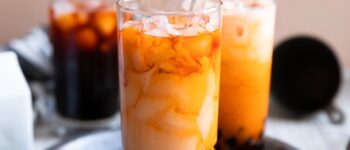Key Concepts Chemistry Food Science Solution Temperature Starch
Introduction Have you ever seen “bubble tea” and wondered what the boba spheres in this drink are—and how they are made? Bubble tea or “boba tea” is a sweetened drink made of flavored tea, milk and bubbles. The translucent, squishy bubbles called boba are very easy to make. You only need three ingredients: tapioca flour, water and brown sugar. The secret lies in one detail: the temperature of the water. Curious? Try it out and make a bubble beverage from scratch!
Background The bubbles in bubble tea are made from tapioca flour, which is a starch. Unlike wheat flour, which contains starches, protein and fiber, tapioca flour contains only starch. And the secret to making bubbles lies in the way starch particles interact with water.
Starch particles are created when a large number of glucose (a form of sugar) units join together. When these particles are mixed with cold water they disperse and float around in the water. This type of mixture is called a suspension, and the suspension of starch in cold water is often referred to as goo or Oobleck. Note that the starch particles do not change when mixed with cold water. When you leave the goo out the water will eventually evaporate and you will have your starch particles again.
See more : Chai Tea Latte Caffeine Content: Sip and Stay Alert
The story changes when you add heat. Starch particles swell and break apart when mixed with hot water. The smaller pieces then create new connections and form a network that can hold water. This process is called starch gelatinization. When this solution cools it becomes more gel-like. With time it will lose water and become stiffer. But no matter how long you wait it will not turn into starch particles again. The addition of heat changed the particles.
Materials
- Stovetop
- Pot
- Water
- Measuring cup
- Measuring spoons
- Brown sugar
- Slotted spoon
- Large bowl
- Tapioca flour (also called tapioca starch)
- Small spoon
- Two small bowls or cups
- Cutting board
- Butter knife
- Adult helper
- Glass of cold uncaffeinated tea with milk (optional)
- Other types of flour, such as corn starch, potato starch or wheat flour (optional)
Preparation
- Ask an adult for help any time you need to handle the stove or hot water.
- Heat three cups of water on the stove until the water boils.
- Add one cup of brown sugar, and stir until the sugar dissolves and forms a syrup. Pour the syrup into a large bowl and set aside to cool.
- Boba, also called tea bubbles or tapioca pearls, are tapioca flour balls cooked in a sugary syrup. You will make two batches: one using cold or room temperature water and another made with boiling hot water. Do you think using cool or hot water will impact the result? If so, how?
- Put a small amount of water in a pan on the stove, and allow it to heat to a boil as you prepare the tapioca flower.
- Have room temperature or cold water on hand as well.
Procedure
- While the water is heating up on the stove measure six teaspoons of tapioca flour into a small bowl. Add six teaspoons of tapioca flour into a second small bowl.
- Take one bowl with tapioca flour. Have a small spoon ready so you are prepared to start mixing. Pour two teaspoons of room temperature or cold water on the tapioca flour, and mix the flour with the water right away. Mix it well, and set aside.
- Take the second bowl with tapioca flour. Once the water on the stove is boiling ask an adult to measure two teaspoons of boiling water and pour them on the tapioca flour. With your small spoon start mixing the flour with the hot water as soon as it is poured in. Mix well.
- Look at the two batches of dough. How are they similar? How are they different?
- One of your doughs is likely clumped together whereas the other one has not. Why do you think this happens? Which one is clumped—the hot water or cool water one?
- Set aside the dough that is not clumping.
- Knead the clumping dough with your hands to make a ball. The dough should feel like playdough. Add a tiny amount of hot water if the dough is too dry or a little flour if it is too sticky.
- While you are kneading the dough ask an adult to heat up two cups of the sugar-and-water syrup solution you made earlier. Leave one cup in a cool place—you will use it later.
- While the syrup heats, transfer the dough to a cutting board, and use your hands to roll it into cylinders with the thickness of a pencil (about five millimeters). Cut each long cylinder into short pieces that are about as long as they are wide. Roll each little piece into a ball. These are your homemade tapioca boba balls!
- Once the syrup is boiling, have an adult add the balls to the boiling syrup (carefully so as not to splash the hot liquid) and cook them. Do the balls initially sink or float? Does that change as the cooking process takes place? Why would that happen?
- Check the progress of the cooking balls every five minutes to see if your bubbles are soft and gooey. It often takes about 20 minutes for the tapioca balls to cook (sometimes smaller balls cook faster and larger ones take longer). The balls will become more translucent, and bubbles will appear in the balls as they cook. Carefully check one or two balls for doneness.
- Once you feel the texture is just right, let them cook just a little bit longer.
- Have an adult scoop the boba out of the boiling syrup with a slotted spoon and place them into the leftover cold syrup to cool.
- Let the boba cool and then have a bite!
- Extra: Make a cup of uncaffinated tea, let it cool, and add milk and some of the brown sugar syrup if desired. Add boba, and enjoy your homemade cup of boba tea!
- Extra: Try making boba with the dough that did not clump. What happens? How does it behave differently from the dough made with the hot water?
- Extra: Leave the cup of your first dough (the one made with cold water) out for a day or two, stirring occasionally. How does it change? Why would this happen? Would the same happen with the dough made with boiling water if that dough was left out for several days? Give it a try.
- Extra: The bubbles (tapioca pearls) get harder when they cool and when they are left out. Explore what happens when you reheat them.
- Extra: Substitute the tapioca flour with another flour, such as corn starch, potato starch or wheat flour. Can you predict which flours will give similar bubbles—and which ones will not?
Observations and Results Did your solution made with hot water create dough balls that could be rolled and cooked into tapioca pearls or boba bubbles? When mixed with boiling hot water starch particles break into smaller pieces that partially dissolve in the water. The pieces make new connections, and as the starch-water mixture cools even more connections are formed. As long as there is not too much water this mixture can hold its structure.
See more : How to Make the Perfect Cup of Loose Leaf Tea
On the other hand, when mixed with cold water tapioca flour starch particles spread out and float around. They do not create new connections that can keep dough together.
When you cook the dough, more changes occur in the starch particles. The tiny gas bubbles you see appearing in the pearls indicate this change. The pearls get their typical chewy, gel-like and translucent appearance.
If you tried letting this mixture of starch particles and cold water sit for a couple of days, stirring it occasionally, you might have noticed you end up with pure starch flour again. The water evaporates and you are left with unaltered starch particles. And, if you tried letting the tapioca dough created with hot water sit for a couple of days, you might have noticed it dries out but does not become starch flour again. The starch particles were altered when they came into contact with hot water and will not reform into their original starch composition.
More to Explore The Scientific Secret of Stretchy Dough, from Scientific American Make Your Own Gelatin Pearls, from Scientific American Mac and Cheese Science: What Makes a Thick Sauce? from Scientific American It’s a Solid… It’s a Liquid… It’s Oobleck! From Scientific American STEM Activities for Kids, from Science Buddies
This activity brought to you in partnership with Science Buddies
Nigel Gildon editor:Nigel Gildon is the editor of Chef Wayne’s Big Mamou: Chef Wayne’s Big Mamou. He has worked in the publishing industry for many years and has a passion for helping new authors get their work into the hands of readers. 63 Liberty Street * Springfield, MA 01003




